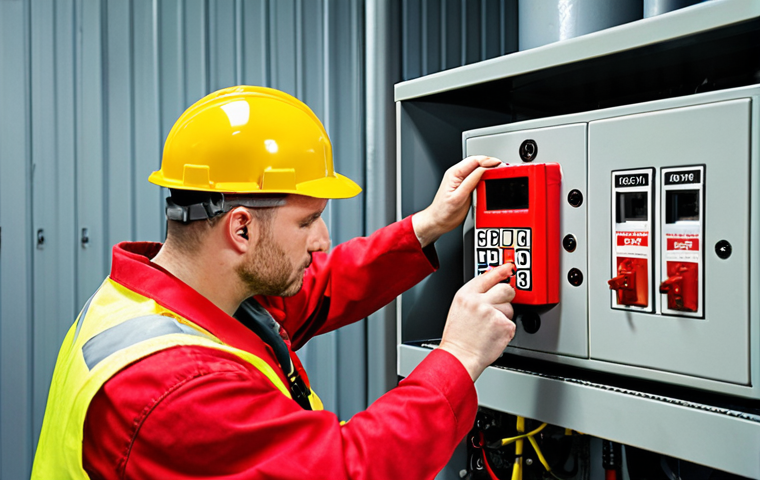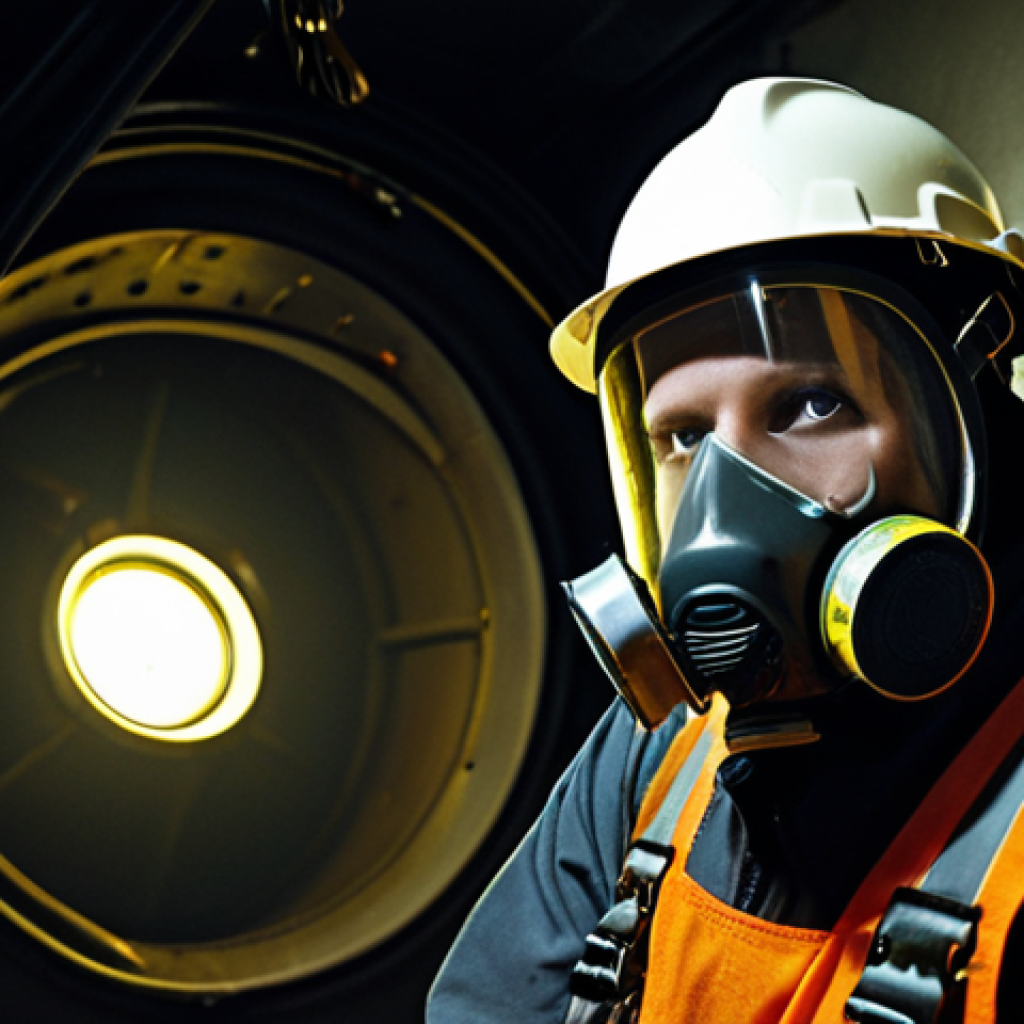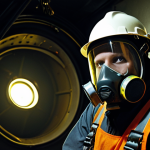The piercing shriek of the emergency alarm cut through the simulated construction site. Dust filled the air, obscuring the mangled scaffolding before me.
As a safety inspector for over 10 years, I thought I’d seen it all, but nothing truly prepares you for the visceral reality of a potential disaster. These industrial accident simulation drills, though stressful, are becoming increasingly vital in today’s rapidly evolving work environments, especially with the rise of AI-powered automation and its potential risks if not managed properly.
I’ve been part of countless safety training sessions, but the integration of VR and real-world recreations has been a game-changer. It’s not just about memorizing protocols; it’s about instinctual response in a high-pressure situation, and adapting to new hazards.
Let’s delve into the details in the article below!
Navigating the Labyrinth of Confined Space Entry: A Survivor’s GuideConfined spaces – the silent killers lurking in plain sight within industrial environments.
I remember one sweltering summer afternoon during a refinery turnaround. A young pipefitter, barely out of his apprenticeship, rushed into a tank without proper ventilation to “save time.” The consequences were nearly tragic.
These spaces, characterized by limited entry and egress and poor natural ventilation, demand meticulous planning and execution. I’ve personally witnessed the horrifying aftermath of oxygen deficiency and toxic gas exposure.
Proper atmospheric testing, continuous ventilation, and a trained standby person are not mere suggestions; they are the lifeline that separates life from death.
Understanding the Hazards

Confined spaces present a cocktail of potential dangers. Oxygen deficiency, the silent asphyxiator, can occur due to rusting, combustion, or displacement by other gases.
Toxic gases, such as hydrogen sulfide (H2S) or carbon monoxide (CO), can accumulate, leading to immediate incapacitation. Flammable atmospheres pose the constant threat of explosion.
Physical hazards, like engulfment by granular materials or moving parts, add another layer of complexity. It’s crucial to recognize that each space is unique, requiring a tailored hazard assessment before entry.
Implementing a Permit-Required System
A permit-required confined space program is the cornerstone of safety. This written program outlines the procedures for identifying, evaluating, and controlling hazards within confined spaces.
It mandates a detailed entry permit that specifies the hazards, necessary precautions, required equipment, and authorized entrants. The permit acts as a checklist, ensuring that all safety measures are in place before anyone sets foot inside.
Furthermore, continuous monitoring of atmospheric conditions during entry is paramount, with immediate evacuation triggered by any alarm. Optimizing Lockout/Tagout Procedures for Energy IsolationImagine a scenario: a maintenance technician, believing a piece of machinery is de-energized, begins repairs.
Suddenly, the machine roars to life, resulting in severe injury or even fatality. This is the nightmare scenario that lockout/tagout (LOTO) procedures are designed to prevent.
LOTO involves isolating hazardous energy sources (electrical, mechanical, hydraulic, pneumatic, etc.) and applying locks and tags to prevent accidental startup during maintenance or servicing.
I’ve seen firsthand how a single lapse in LOTO can have devastating consequences.
Developing Comprehensive LOTO Procedures
Effective LOTO starts with clearly written procedures for each piece of equipment. These procedures should identify all potential energy sources, the steps for isolating them, and the specific lockout devices required.
Training is key. All employees who perform maintenance or servicing must be thoroughly trained on LOTO procedures, as well as authorized employees. Regular audits of LOTO procedures and practices are essential to identify weaknesses and ensure ongoing compliance.
Utilizing Group Lockout Strategies
Group lockout addresses situations where multiple workers are involved in the same maintenance task. A primary authorized employee is responsible for coordinating the lockout and ensuring that all members of the group are protected.
Each worker attaches their personal lock to a group lockout device, such as a hasp, ensuring that the energy source cannot be restored until everyone has removed their lock.
This system promotes individual accountability and prevents unauthorized energy restoration. Enhancing Fall Protection Measures in Elevated Work AreasFalls are a leading cause of workplace fatalities.
I recall a time when I witnessed a construction worker, improperly harnessed, slip on a steel beam several stories high. The image is forever etched in my mind.
Fall protection is not merely about wearing a harness; it’s about a comprehensive system that includes hazard identification, proper equipment selection, training, and rescue planning.
Selecting the Right Fall Protection Equipment
The hierarchy of fall protection starts with eliminating the hazard altogether. If that’s not possible, engineering controls, such as guardrails or safety nets, should be implemented.
When these controls are not feasible, personal fall arrest systems (PFAS) become necessary. PFAS consist of a full-body harness, a lanyard or self-retracting lifeline, and an anchorage point.
Selecting the right equipment is critical. The harness must fit properly, the lanyard must be of the correct length, and the anchorage point must be strong enough to withstand the forces generated during a fall.
Implementing a Comprehensive Fall Protection Program
A fall protection program should include a written plan, hazard assessments, equipment inspections, and training. Regular inspections of harnesses, lanyards, and anchorage points are essential to identify any damage or wear.
Workers must be trained on the proper use, inspection, and maintenance of their fall protection equipment. Furthermore, a rescue plan must be in place to quickly retrieve a worker who has fallen and is suspended in their harness.
Suspension trauma, a potentially fatal condition caused by prolonged suspension, can occur within minutes. Heat Stress Management: Staying Cool Under PressureWorking in hot environments puts employees at risk of heat stress, a range of conditions from heat rash to heat stroke.
I remember a colleague who collapsed on a blacktop during a summer paving job. His core temperature soared, and he became disoriented. Fortunately, we recognized the symptoms and were able to cool him down quickly.
Heat stress is preventable with proper planning and precautions.
Understanding the Risk Factors for Heat Stress
Several factors contribute to heat stress, including high air temperature, humidity, radiant heat sources (such as the sun or furnaces), and physical exertion.
Personal factors, such as age, weight, medical conditions, and acclimatization, also play a role. Recognizing these risk factors is the first step in preventing heat stress.
Implementing Effective Heat Stress Controls
Engineering controls, such as providing air conditioning, ventilation, and reflective shielding, can reduce heat exposure. Administrative controls, such as scheduling work during cooler times of the day, providing frequent rest breaks, and implementing a buddy system, can also be effective.
Personal protective equipment (PPE), such as cooling vests and wide-brimmed hats, can help workers stay cool. Hydration is critical. Workers should drink plenty of water or electrolyte-replenishing beverages throughout the day.
Education and training are essential to teach workers how to recognize the symptoms of heat stress and what to do if they or a coworker experience them.
| Control Method | Description | Example |
|---|---|---|
| Engineering Controls | Modifying the work environment to reduce heat exposure. | Installing air conditioning in break rooms, providing shade structures. |
| Administrative Controls | Changing work practices to minimize heat stress. | Scheduling strenuous tasks for early morning, implementing mandatory rest breaks. |
| Personal Protective Equipment (PPE) | Providing equipment to help workers stay cool. | Cooling vests, wide-brimmed hats, breathable clothing. |
| Hydration | Ensuring workers have access to water or electrolyte drinks. | Providing water coolers at work sites, encouraging frequent hydration. |
The Role of Regular Safety Audits and InspectionsWalking through a chemical plant once, I noticed a corroded pipe leaking a hazardous substance. A quick report prevented a potentially catastrophic release.
Regular safety audits and inspections are vital for identifying hazards before they lead to accidents. They provide a fresh perspective and help to ensure that safety procedures are being followed.
Conducting Comprehensive Safety Audits
Safety audits involve a systematic review of an organization’s safety program to assess its effectiveness. This includes reviewing written policies, procedures, training records, and incident investigations.
Audits should be conducted by qualified individuals who are independent of the department being audited. The audit findings should be documented and used to develop an action plan for addressing any deficiencies.
Performing Routine Safety Inspections
Safety inspections involve a walk-through of the workplace to identify hazards. This includes inspecting equipment, work areas, and employee work practices.
Inspections should be conducted regularly, with the frequency depending on the nature of the work and the potential hazards. Inspection findings should be documented and promptly corrected.
Cultivating a Strong Safety Culture: Leading by ExampleUltimately, safety is not just about following rules; it’s about creating a culture where everyone is committed to protecting themselves and their coworkers.
As a safety professional, I strive to instill this mindset in every worker I encounter.
Promoting Employee Involvement in Safety
Employees are the eyes and ears of the workplace. They are often the first to identify hazards and suggest solutions. Encouraging employee involvement in safety through safety committees, hazard reporting systems, and toolbox talks can significantly improve safety performance.
Demonstrating Management Commitment to Safety
Management commitment is essential for creating a strong safety culture. When leaders prioritize safety and hold themselves and others accountable for safety performance, it sends a clear message that safety is valued.
This includes providing the resources necessary to implement safety programs, actively participating in safety activities, and recognizing employees who demonstrate a commitment to safety.
Navigating the labyrinth of workplace safety can seem daunting, but with a proactive approach, commitment to training, and a culture that prioritizes well-being, we can create environments where everyone goes home safe.
I’ve seen firsthand the impact of vigilance and preparedness. Let’s continue to learn, adapt, and champion safety in all that we do. Remember, a safe workplace is not just a goal; it’s a fundamental right.
In Conclusion
Safety isn’t just a set of rules; it’s a mindset we cultivate daily. By prioritizing hazard identification, implementing effective controls, and fostering a culture of care, we empower ourselves and our colleagues to work safely. Let’s remain vigilant, share our experiences, and champion safety in all aspects of our work.
Remember, every action we take, every decision we make, has the potential to impact not only our own well-being but also the well-being of those around us. Let us commit to making safety our priority, ensuring that everyone can return home safely to their loved ones each day.
Through continuous learning, proactive measures, and a strong commitment to safety, we can create workplaces where accidents are minimized, and everyone can thrive. Together, let’s build a culture of safety that protects our most valuable asset: our people.
Helpful Tips
1. First Aid and CPR Training: Equip yourself with essential skills to respond to emergencies effectively. Local community centers or hospitals often offer these courses.
2. Utilize Safety Apps: Download apps like the OSHA Heat Safety Tool or the NIOSH Sound Level Meter to monitor workplace conditions and potential hazards on your smartphone. They’re like having a pocket-sized safety officer!
3. Emergency Preparedness Drills: Participate in regular drills to familiarize yourself with evacuation routes and emergency procedures. It’s better to know what to do beforehand than to panic in a real crisis.
4. Know Your Rights: Familiarize yourself with your rights as a worker under OSHA regulations. Understand how to report safety concerns without fear of retaliation.
5. Stay Updated: Keep abreast of the latest safety guidelines and industry best practices. Attend workshops, webinars, or subscribe to safety newsletters to remain informed.
Key Takeaways
– Proactive Hazard Identification: Regularly assess your work environment to identify potential hazards before they cause harm.
– Effective Control Implementation: Implement control measures such as engineering controls, administrative controls, and PPE to mitigate identified risks.
– Continuous Training & Education: Provide ongoing training to ensure workers are knowledgeable about safety procedures and best practices.
– Employee Empowerment: Encourage employee involvement in safety initiatives and create a culture where safety concerns are openly reported and addressed.
– Management Commitment: Demonstrate unwavering management support for safety through resource allocation, active participation, and accountability.
Frequently Asked Questions (FAQ) 📖
Q: What’s the main reason for the increased importance of industrial accident simulation drills?
A: Honestly, it’s because workplaces are changing so damn fast, especially with AI coming into the picture. I’m talking about AI-powered automation. These drills aren’t just about following some dusty old manual.
They’re about training your gut to react when things go sideways, and that’s more critical than ever with these new technologies potentially introducing unpredictable hazards.
You can’t just read about a safety protocol; you have to feel the heat.
Q: How has the integration of VR and real-world recreations impacted safety training sessions?
A: Man, it’s been a total game-changer, I tell ya. Before, it was all lectures and slides. Now, we’re throwing people into these incredibly realistic scenarios.
The VR stuff is wild, like you’re really there, feeling the pressure. And the real-world recreations? You get to see and even smell things like leaking gas or sparks from faulty wiring.
It’s not just memorizing anymore; it’s about learning to respond instinctively and adjust to different, unexpected situations. Trust me, feeling that “oh crap” moment in a safe environment can save lives later.
Q: What makes being a safety inspector of 10 years so challenging?
A: Look, after all this time, you think you’ve seen every worst-case scenario. But what is tough is when new tech comes in and changes the rules of the game, because now the accidents are different and the old rules may not work.
So, you have to keep learning and adapting, or people could end up hurt. You have to be ready for anything, and honestly, that’s a heavy responsibility.
📚 References
Wikipedia Encyclopedia





